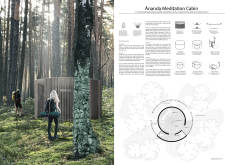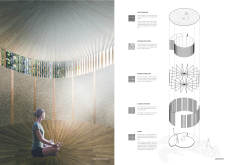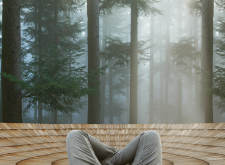5 key facts about this project
Functionally, the cabin presents spaces meant for meditation and contemplation, accommodating both individual and group practices. At its core, the design encourages activities that promote well-being, making it a versatile environment for various forms of meditation. Each component of the cabin has been carefully considered to support these activities, ensuring that users feel a sense of peace and connection while inside.
The unique design approach is evident in the cabin's circular form, which not only enhances aesthetic appeal but also facilitates a sense of unity and flow within the space. This geometry symbolizes continuity and inclusivity, allowing individuals to engage with both the interior and the exterior effortlessly. Strategic placement of windows and openings maximizes natural light, creating an inviting atmosphere that strengthens the connection to the forest beyond its walls.
Key elements of the cabin include a central core that is designed for communal gatherings, promoting social interaction while still allowing for personal meditative practices around the perimeter. This layout fosters a balance between solitude and community, reflecting the dual nature of meditation itself. The wooden deck, which spirals inward, serves as a physical connection to the earth and directs the focus of users towards the center, enhancing the meditative experience.
Materiality plays a crucial role in the overall character of the cabin. The use of natural materials such as wood and plaster not only aligns the structure with its environment but also provides sensory warmth. The wood used throughout the cabin creates a cozy ambiance, while the wood fiber insulation ensures sustainability and climate control. Large expanses of glass integrate transparency into the design, allowing the forest environment to merge with the indoor spaces, reinforcing the connection between nature and self.
The interplay of light and space is another distinct feature of this architectural project. As sunlight filters through the layered wooden slats of the exterior, it creates a dynamic pattern of light and shadow within, enhancing the sensory experience for those inside. This thoughtful design encourages occupants to be mindful and present, reinforcing the principles of meditation.
One of the project’s standout aspects is its commitment to sustainability. Each design choice reflects a respect for ecological balance, whether in the selection of materials or the strategic use of energy-efficient systems. The cabin is not just a space for isolation; it is a thoughtful response to the ecological and social context of its surroundings.
For readers interested in a deeper understanding of this architectural project, exploring the architectural plans, sections, and ideas behind the Ānanda Meditation Cabin can provide additional insights into how the design effectively meets its objectives. The combination of innovative design practices and a dedicated focus on user experience makes this project a meaningful contribution to contemporary architecture.


























